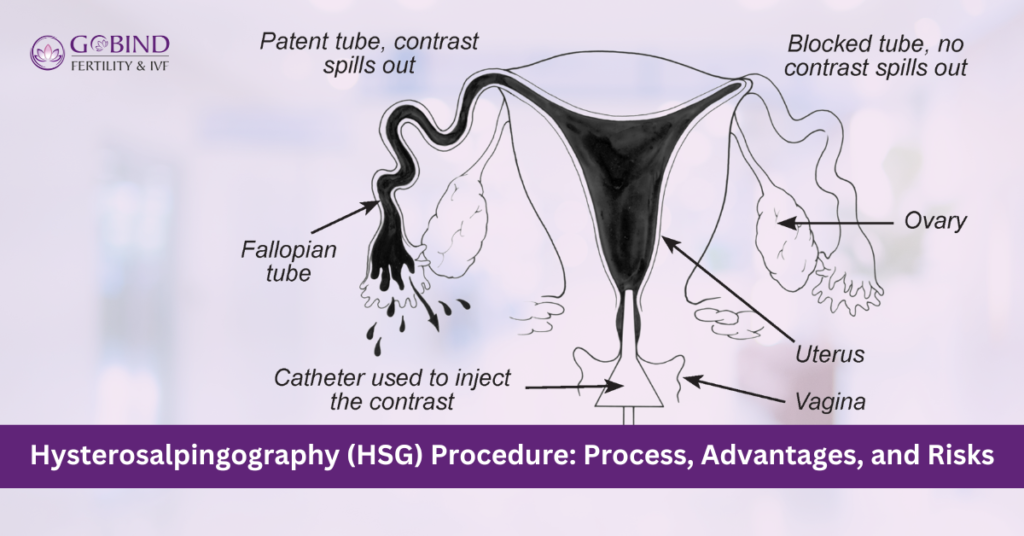Hysterosalpingography (HSG) Procedure: Process, Advantages, and Risks

Hysterosalpingography (HSG) is a specialized medical imaging technique used to evaluate the uterus and fallopian tubes. This procedure is commonly performed in cases of infertility or recurrent pregnancy loss to assess abnormalities in the reproductive anatomy. Understanding the process, advantages, and potential risks associated with HSG can help individuals make informed decisions about their care.
The HSG Procedure
HSG is an outpatient procedure conducted in a radiology or gynaecology clinic. It involves X-ray imaging and a contrast dye to visualize the reproductive organs. The key steps include:
- Preparation:
- The procedure is usually scheduled after menstruation but before ovulation (typically between days 7 and 10 of the menstrual cycle) to minimize the chance of pregnancy.
- Patients may be advised to take an over-the-counter pain reliever, such as ibuprofen, an hour before the procedure to reduce discomfort.
- Antibiotics may be prescribed to prevent potential infections.
- The Procedure:
- The patient lies on an X-ray table, and a speculum is inserted into the vagina to expose the cervix.
- A thin catheter is inserted through the cervix into the uterus. Once the catheter is in place, the speculum is removed.
- A contrast dye is slowly injected through the catheter. This dye fills the uterus and fallopian tubes, highlighting their shape and structure on the X-ray images.
- X-rays are taken in real-time, allowing the radiologist or gynaecologist to observe the dye’s flow.
- The procedure typically takes 15-30 minutes.
- Post-Procedure:
- After the HSG, the patient may experience mild cramping, spotting, or vaginal discharge as the dye is expelled.
- Normal activities can usually be resumed immediately, but it’s advisable to avoid intercourse for 24-48 hours.
Advantages of HSG
HSG offers several benefits, particularly for individuals facing fertility challenges:
- Diagnosis of Structural Abnormalities:
- The procedure can detect uterine abnormalities such as fibroids, polyps, adhesions, or congenital anomalies.
- It identifies blockages in the fallopian tubes, which can prevent the sperm and egg from meeting.
- Minimally Invasive:
- HSG is a non-surgical diagnostic tool, making it less invasive than laparoscopy.
- Therapeutic Potential:
- In some cases, the injection of contrast dye can dislodge minor blockages in the fallopian tubes, improving fertility.
- Quick and Convenient:
- The procedure is completed within a short time frame and does not require extensive recovery.
- Guidance for Further Treatment:
- Results from HSG can guide fertility treatments, such as in-vitro fertilization (IVF) or corrective surgery.
Risks and Complications
While HSG is generally safe, there are some potential risks to consider:
- Discomfort and Pain:
- Many patients experience cramping during and shortly after the procedure. Severe pain is rare but may occur in cases of tubal blockage.
- Allergic Reactions:
- A reaction to the contrast dye is uncommon but can occur in sensitive individuals. Symptoms may include itching, rash, or more severe reactions like difficulty breathing.
- Infection:
- There is a small risk of developing a pelvic infection, particularly in individuals with a history of pelvic inflammatory disease (PID).
- Radiation Exposure:
- Although the radiation dose is low, it is not recommended during pregnancy. This is why timing the procedure during the early menstrual cycle is critical.
- False Positives/Negatives:
- HSG may not always provide conclusive results. Additional diagnostic tools, such as sonohysterography or laparoscopy, may be needed.
Who Should Consider HSG?
HSG is recommended for individuals:
- Experiencing difficulty conceiving after one year of unprotected intercourse (or six months if over age 35).
- With a history of recurrent pregnancy loss.
- Suspected of having uterine or tubal abnormalities.
If You’re experiencing the same issues, consult our fertility expert Dr Manju Khurana at Gobind Fertility & IVF Centre in Hisar.
Conclusion
Hysterosalpingography is a valuable diagnostic procedure in the evaluation of female fertility. While the process may involve temporary discomfort, its ability to identify structural issues in the reproductive organs makes it an essential tool in fertility assessment.
Patients should discuss their medical history, concerns, and goals with their fertility specialist to determine whether HSG is the right choice for them. By understanding the procedure, its benefits, and its risks, individuals can approach the process with greater confidence and clarity.
